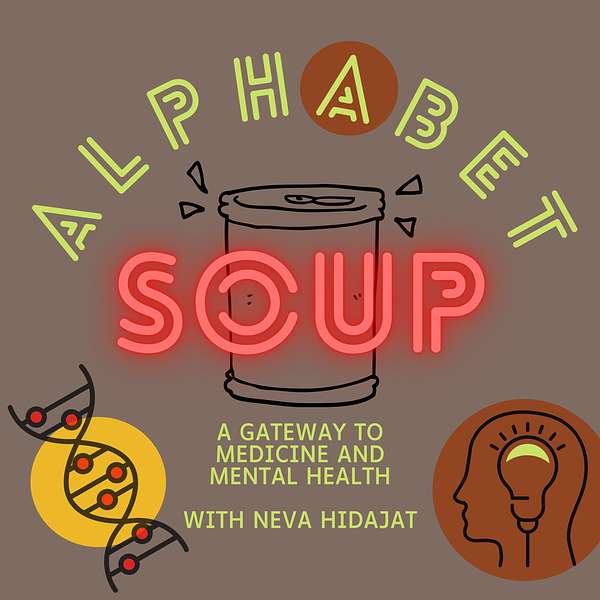
Alphabet Soup: A Mental Health & Medicine Podcast
Alphabet Soup: A Mental Health & Medicine Podcast
Ep.24 Balneotherapy
Today we explore the ancient practice of bathing in mineral waters! Balneotherapy is one of the most luxurious ways to relax and has evolved into a popular method in many countries from Belgium to Japan today! We'll also talk about how you can experience balneotherapy from the comfort of your own home. Hit play to learn more!
Balneotherapy is a form of therapy that dates back more than a thousand years. In today’s episode, we’ll find out more about this ancient method of healing and relaxation that even Cleopatra loved. We’ll also learn about how you can experience balneotherapy’s healing effects for yourself, at home! So, stick around to learn how to relax the Cleopatra way.
Balneotherapy is the practice of bathing in mineral-rich water or mud for the treatment of disease, particularly skin conditions. Additional benefits include muscle relaxation, stress relief, temporary relief from chronic pain, and improvements in sleep and mood.
As early as 500 BC, scientists were investigating the properties of mineral springs to aid in healing skin diseases and to relieve muscle pain. The practice continued and, later, Europe especially became a center for spa culture enthusiasts. Grand Spa resorts began popping up at almost every mineral water spring and these resorts, attracting many visitors, have become an important part of the economy in cities across Europe. One town in Belgium that is particularly famous for its spas is literally called the Belgium town of Spa.
Although the world was not deliberately connected thousands of years ago, historic records show how the practice of bathing in mineral springs was not exclusive to one culture but a common thread shared amongst many cultures and locations throughout the world. A 3000-year-old Japanese history book called Nihon Shoki, mentions specific mineral spas, known as Onsen, that one can still visit today. The locations that the book mentions include Arima, Shirahama, and Dogo Onsen, for reference. Bathing in Onsen was identified as a purifying ritual in the Shinto religion and an activity enjoyed by emperors. Overtime, the culture spread to the citizens as well and today, many naturally occurring Onsen have become popular sites for relaxation amongst the Japanese people, and tourists. Amazing how the concept of bathing continues to connect humans through history, this includes the Egyptian queen Cleopatra.
Sometime in 69 – 30 BC, Cleopatra visited the Dead Sea to soak in its mineral rich waters. It is because of Cleopatra that the sea became notorious for its healing properties. Today, the dead sea still attracts many visitors who are curious to experience the healing effects of swimming – or more appropriately floating – there.
If you’re not able to book a spontaneous plane ticket to the Dead Sea, but are still looking to enjoy the effects of balneotherapy here’s how to do it from the comfort of your very own home. You’ll need a bathtub, access to running water, and bath salts. Your typical drugstore will probably carry bath salts, but I also did some research, and you can even purchase Japanese Onsen Mineral packets derived from the original hot spring locations. So, once you’re ready for a bath, fill the tub with warm water. To simulate mineral hot springs, the water should be pretty warm, roughly between 30 to 40 degrees Celsius, but ultimately whatever temperature is comfortable for you is best. Then, dissolve a generous amount of bath salts into the water. Hot springs are known for having high mineral content so you can’t go wrong with more bath salts! After that you’re good to settle in the tub and enjoy your balneotherapy at home! Although if you did want to take it a step further, you could infuse a few drops of essential oils into your bath too. Essential oils have their own healing properties in aromatherapy including treatment for headaches, insomnia and stress. Adding those to your balneotherapy treatment is optional of course, the real hero are the minerals, but it probably wouldn’t hurt! So, there you have it, balneotherapy is possible at home too. And it has to be one of my favorite methods of home therapy and I hope you’ll try it out too.
Since today’s episode is about relaxation and de-stressing, here’s a quote that matches that energy for today’s bit. “Stress is not what happens to us. It’s our response to what happens. And response is something we can choose.” Maureen Killoran is credited with this quote. It reminds us that we are ultimately in control of how we deal with situations that may be stressful. Sometimes, a well-deserved response to something stressful might just be a nice, long soak in a mineral bath.
Alright guys, I hope you enjoyed this episode and I hope you try taking a mineral bath! As always, if you liked this episode feel free to share it with your friends and family and I’ll see you next week!